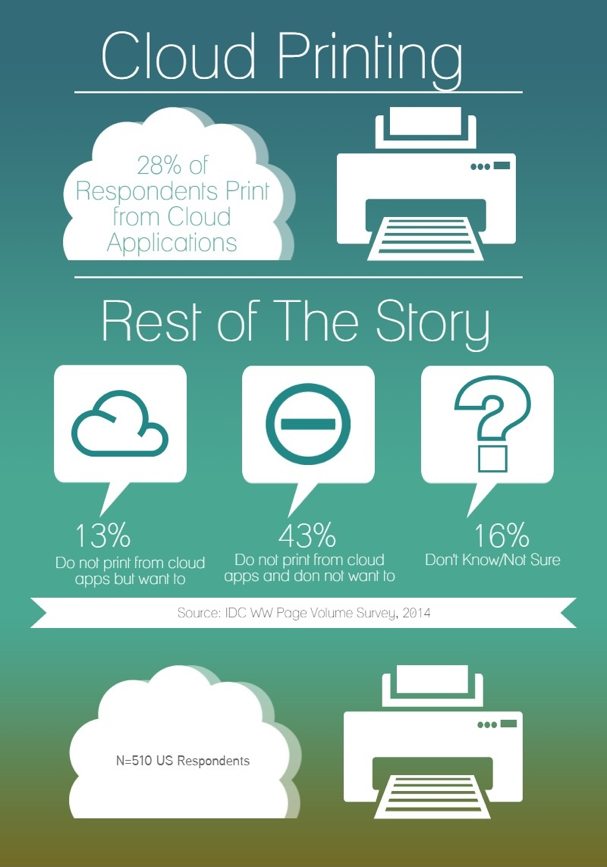
In an ideal world, workers would easily be able to move seamlessly between paper, digital and even legacy formats from any information technology (IT) platform that they wished. Integration of information would happen across all repositories—cloud or on-premise—and, as a result, drive knowledge worker productivity and improved business outcomes. At the core of this ideal is the ability to allow workers to collaborate on the devices they prefer to use and have traceability no matter where a document sits in the workflow. However, the real world of document management and collaboration is messier, and IDC research has found that many organizations are still trying to figure out how to implement smart business processes for their workers. That said, mobility and cloud are two transformational paradigms that organizations should consider when looking to provide workflows that are closer to the "ideal."
In a previous blog, we discussed the importance of having a mobile strategy for document management and the challenges associated with allowing workers to use their mobile devices for document management. While the idea of implementing a strategy around mobile can be daunting, enabling mobility is a core requirement for enabling collaboration between today's knowledge workers.
A study conducted by IDC in 2014, with 510 US-based end users, showed that 28% of their business tasks were completed on smartphones and 22% of their time was spent doing business tasks on tablets. Additionally, 48% of respondents wanted to or currently printed documents from their smartphones, and 65% of respondents wanted to or currently printed documents from their tablets. Historical IDC data shows that mobility actually drives print volume, and documents that are printed are those that in theory would live only in the digital world, such as email correspondence or web content. It is important that organizations remember that print documentation cannot be forgotten when looking to improve workflow processes and worker collaboration.
Enabling mobility in an organization is just one piece of the puzzle when looking to improve collaboration among workers. Cloud platforms and applications in partnership with mobility are key in supporting collaboration and smart workflows. Cloud platforms and applications give mobile users the ability to access document content across multiple devices anytime, from anywhere. Just over 80% of respondents in the IDC survey used some form of cloud application, such as Dropbox or Box, for document storage and access. Of those using cloud applications for documents, only 28% of respondents print from their cloud application of choice. The majority of respondents noted that they do not print from cloud storage applications because either the solution does not have print capabilities or the printing functionality available is not robust enough.

Limitations for print means that cloud applications now become a separate silo from mobile to print, cloud to print, capture to cloud or mobile to capture workflows. This means that collaboration among workers becomes strained and that users may have important documents stored in public cloud applications that potentially are at risk of a security breach. Additionally, it also means that there is a gap that prohibits the automation or optimization of processes. These concerns are why organizations need to support cloud-based applications for document storage, mobility and printed output.
IDC suggests looking for solution vendors that either offer a range of cloud, mobile or managed print service (MPS) software solutions or best-of-breed applications that have open application program interfaces (APIs) to make sure that all document workflows can come together, regardless of department or device. Many multifunction printer (MFP) vendors offer cloud connectors on either a free or premium level. For small- to medium-sized businesses, cloud connectors to popular public cloud file services, such as Google Drive, Microsoft OneDrive and SharePoint, tend to be available for free from MFP vendors. On the premium side of the market, MFP cloud connectors tend to offer more options, configuration capabilities and personalization in contrast to free cloud connectors, like multiple personalized user accounts for a firm versus the single-user account in free connectors. It's important to note that MFP cloud connectors tend to be used when there is an annotation on a document that needs to be scanned and uploaded to a data store or the original source is a paper document (for more information on MFP Cloud Connectors, please see the IDC report "MFP On-Ramp to Cloud Services — Revenue Opportunity or Competitive Parity?").
The key takeaway for encouraging an environment for document collaboration and to enable smart business processes is that such capabilities allow organizational repositories for document storage, process automation/optimization, secure practices and encourages collaboration. For those looking for the bottom line, partnering cloud and mobility allows for reduced cost and time saved for workers—now the next step is to commit to transformational technology adoption.
Arianna Valentini is a senior research analyst on IDC's Hardcopy Industry Transformation and Page Volume Analysis research team. She is responsible for developing core service deliverables and custom research projects for clients, with a focus on how IDC's third platform is effecting industry transformation within the hard copy market. Ms. Valentini's areas of expertise include mobile technology, digital publishing software, brand strategy, market and trend analysis. Follow her on Twitter @LilVPrinterMC.
















